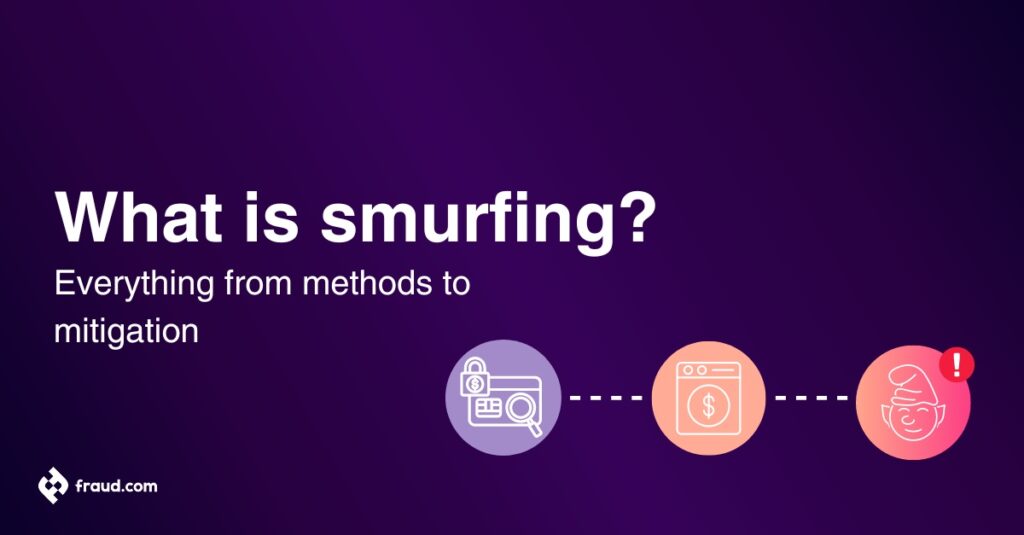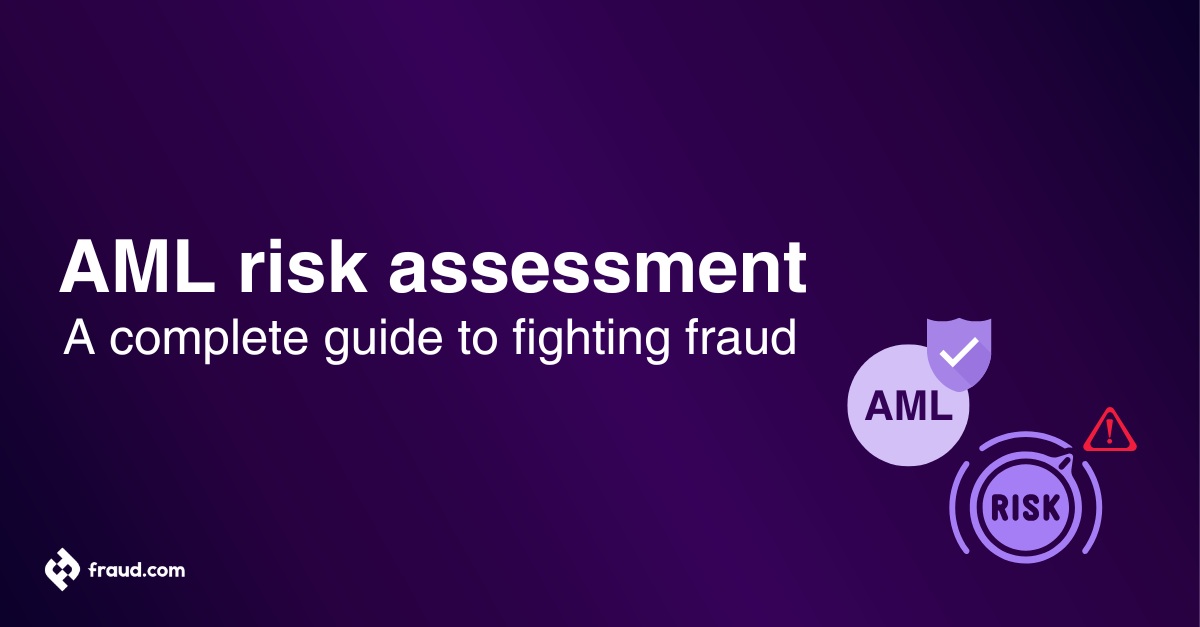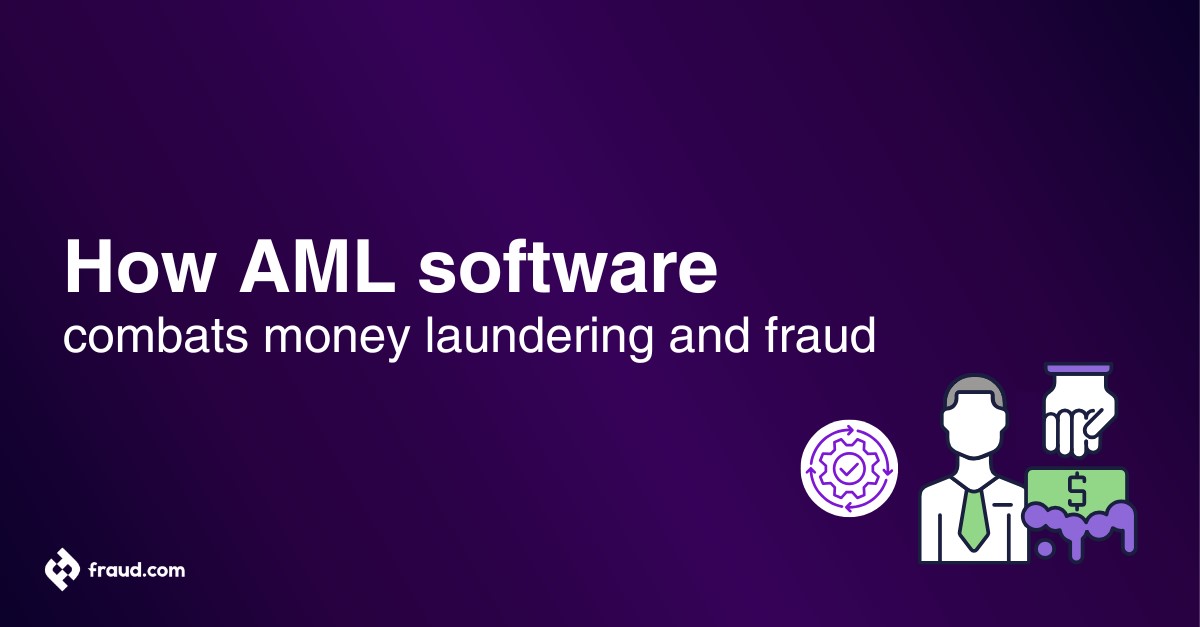In the complex world of financial fraud, smurfing stands out as a sophisticated technique used by fraudsters to launder money and evade detection. At fraud.com, we understand the critical importance of staying ahead of these illicit activities to protect businesses and financial institutions.
This comprehensive guide delves into the intricate methods employed in smurfing, we also explore the latest strategies and technologies designed to detect and mitigate smurfing, providing you with essential knowledge to safeguard your organization. Whether you’re a financial professional, regulator, or simply someone interested in understanding financial fraud, this article offers valuable insights into one of the most pervasive challenges in the industry.
Table of Contents
ToggleWhat is smurfing?
Smurfing is a money laundering technique where large sums of illicit money are broken down into smaller, less noticeable transactions to evade detection by regulatory authorities. These smaller amounts are spread across various bank accounts to avoid triggering reporting thresholds set by financial institutions.
The term “smurfing” likens these numerous small transactions to the cartoon characters “The Smurfs” collectively achieving a larger goal. Understanding smurfing is essential for financial professionals and institutions to develop effective Anti-Money Laundering (AML) strategies.
What is smurfing in banking?
Smurfing in banking is a method criminals use to bypass anti-money laundering controls by making multiple small transactions instead of a single large one. By keeping deposits, transfers, or withdrawals below reporting thresholds, they avoid triggering alerts and scrutiny from financial institutions.
Banks combat smurfing with AI-driven transaction monitoring, identity verification, and pattern analysis via fraud risk scoring to detect suspicious activity. Identifying irregular transaction patterns, such as frequent small deposits across multiple accounts, is key to preventing financial crime.
What is a smurf?
A smurf is someone who makes small transactions to help launder large sums of money. Smurfs can act knowingly or be used unwittingly in these schemes, making multiple deposits, withdrawals, or transfers that seem innocent individually but are part of a larger fraud.
Understanding smurfing
Smurfing is a term used in money laundering to describe a method where illicit funds are broken into smaller amounts to avoid detection. It is typically used by criminals to obscure the source of illegal money by using various individuals or entities, known as “smurfs,” to carry out transactions. This practice can be seen across a wide range of criminal activities, including drug trafficking, fraud, and corruption. The key goal of smurfing is to introduce illicit money into the financial system in a way that circumvents the traditional monitoring systems designed to detect large-scale illegal activities.
How does smurfing work?
Smurfing operates through a series of well-coordinated steps designed to launder money by breaking it into smaller, less detectable amounts. Here’s how this process typically works:
Aggregation of illicit funds: Criminals accumulate large sums of money from illegal activities, such as drug trafficking, fraud, or corruption.
Recruitment of smurfs: Individuals, known as smurfs, are recruited to assist in the laundering process. They might be willing participants or unaware of the larger scheme.
Distribution of funds: The large sum of illicit money is divided into numerous smaller amounts, often kept below reporting thresholds to avoid triggering a Currency Transaction Report (CTR).
Multiple transactions: They make multiple smaller deposits, withdrawals, or transfers across various bank accounts and financial institutions. This can include:
- Deposits: They may deposit small amounts into different bank accounts.
- Transfers: Funds are transferred between multiple accounts to further obscure the money trail.
- Purchases: They may buy goods or financial instruments that can later be sold to generate clean money.
Placement: The initial step where illicit funds are introduced into the financial system, often through small deposits.
Layering: These transactions create layers of financial activity that distance the illicit funds from their illegal origins, making it harder to trace.
Integration: Finally, the cleaned money is reintroduced into the legitimate economy, often through investments, businesses, or other legal channels, appearing as legitimate earnings.
By breaking down large sums into smaller, seemingly innocuous transactions, smurfing helps criminals evade detection and successfully launder money. Financial institutions must monitor for patterns, red flags, and irregularities in transactions to identify and stop smurfing activities. Suspicious activity, such as frequent small transactions that seem to have no legitimate purpose, should be reported and investigated.
At fraud.com, we provide the knowledge and tools necessary to detect these patterns and enhance your anti-money laundering strategies, ensuring your organization can effectively combat this sophisticated form of fraud.
Examples of smurfing
To understand smurfing better, let’s look at some real-world scenarios where this money laundering technique is employed:
Cash deposits across multiple banks: A criminal organization collects a large sum of money from illegal activities. They then recruit several smurfs to deposit amounts under $10,000 into different bank accounts across multiple banks, avoiding the reporting threshold. These deposits are spread out over several days to further evade detection.
Frequent small wire transfers: Smurfs are instructed to make numerous small wire transfers from different accounts to an offshore account. Each transfer is kept below the regulatory reporting limit, and the destination account aggregates these small amounts into a large, laundered sum.
Purchase and resale of high-value items: Criminals provide smurfs with cash to purchase high-value items like jewellery, electronics, or prepaid cards. These items are then resold, and the proceeds are deposited into different bank accounts. The small resale amounts appear legitimate and mask the origin of the funds.
Casino transactions: Smurfs are given illicit cash to buy casino chips in small amounts. They then gamble minimally or not at all and cash out the chips for checks or bank transfers. This process gives the appearance of legitimate gambling winnings.
Online payment platforms: Smurfs use online payment platforms to transfer small amounts of money to various accounts. By using different accounts and small transfers, they avoid detection by anti-money laundering systems. These small transactions are then consolidated into a single account.
Structured bank withdrawals: A large sum of illicit money is broken down, and smurfs withdraw small amounts from ATMs over time. These withdrawals stay below the ATM limit and are distributed across multiple accounts and cards.
By employing these and other common methods, fraudsters use smurfing to launder money while minimizing the risk of detection. Recognizing these examples helps financial institutions to develop better monitoring financial systems and enhance their anti-money laundering efforts.
At fraud.com, we provide detailed analysis and cutting-edge tools to help you detect and prevent smurfing, ensuring your organization remains vigilant against this form of financial fraud.
What is cuckoo smurfing?
Cuckoo smurfing is a sophisticated and deceptive form of money laundering that exploits legitimate international remittance channels. This technique derives its name from the cuckoo bird, which lays its eggs in other birds’ nests. Similarly, cuckoo smurfing involves inserting illicit funds into legitimate transactions, making them difficult to detect. Here’s how it works:
- Infiltration of remittance networks: Criminals infiltrate legitimate remittance networks used by individuals to send money abroad. They identify remittance companies or agents that facilitate cross-border money transfers.
- Exploiting innocent parties: An innocent party in one country deposits money with a remittance service to send to a recipient in another country. Unbeknownst to them, the remittance company is compromised by money launderers.
- Substitution with illicit funds: Instead of using the depositor’s legitimate funds, the remittance company substitutes it with an equivalent amount of illicit money from local criminals. The legitimate money is then used by the criminals domestically.
- Cross-border transfers: The illicit funds are transferred to the recipient in the foreign country as if they were the legitimate remittance. This process hides the origin of the criminal proceeds, making it appear as a regular remittance transaction.
- Completion of the cycle: The recipient abroad receives the money without knowing its criminal origins. Meanwhile, the legitimate funds deposited by the initial sender are used by criminals locally, completing the laundering cycle.
Cuckoo smurfing is challenging to detect because it involves genuine remittance channels and unsuspecting individuals. Financial institutions need to be vigilant about irregular patterns in remittance transactions, such as frequent deposits and transfers that do not match the typical behavior of the account holder.
What is the difference between smurfing and structuring?
While smurfing and structuring are often used interchangeably, they have distinct differences in the context of money laundering and financial fraud:
Smurfing:
- Definition: Smurfing involves breaking down large sums of illicit money into smaller transactions to evade detection by financial institutions and regulators.
- Method: Smurfs, or individuals involved in the scheme, conduct numerous small transactions, such as deposits, transfers, or purchases, typically staying below the reporting threshold (e.g., $10,000 in the U.S.).
- Complexity: Smurfing often involves multiple people and accounts to further complicate the money trail, making it more difficult for authorities to trace the origin of the funds.
Structuring:
- Definition: Structuring, also known as “smurfing” in some contexts, specifically refers to the act of dividing a large financial transaction into smaller amounts to avoid triggering reporting requirements.
- Method: Individuals perform a series of smaller transactions that collectively amount to a large sum. These transactions are designed to avoid regulatory scrutiny by keeping each transaction below the reporting threshold.
- Simplicity: Structuring can be a simpler process compared to smurfing, as it does not necessarily involve multiple people. Instead, it focuses on breaking down transactions to avoid detection.
Key Differences:
- Scope: Smurfing is broader and can involve multiple individuals and various types of transactions across different institutions. Structuring is more specific to breaking down a single large transaction into smaller parts.
- Participants: Smurfing typically involves several people (smurfs) working together, whereas structuring can be carried out by a single individual.
- Complexity: Smurfing often employs more complex methods and coordination, involving various accounts and institutions. Structuring is straightforward, focusing solely on splitting transactions to bypass reporting limits.
Understanding the nuances between smurfing and structuring is crucial for financial institutions and regulators to implement effective anti-money laundering measures. Recognizing the signs of both practices helps in developing targeted strategies to detect and prevent these illicit activities.
How to prevent smurfing with AI-Powered identity verification
AI-powered identity verification helps prevent smurfing by confirming the user’s identity and leveraging advanced systems can help detect fraudulent activities and identify suspicious patterns. Here’s how AI can help:
- Real-time user verification: AI instantly verifies identities, ensuring users are legitimate and not involved in smurfing schemes.
- Behavioral analysis: AI analyzes transaction patterns to detect small, frequent deposits or transfers, flagging suspicious activity.
- Cross-platform monitoring: AI monitors transactions across multiple platforms, making it easier to spot smurfing across different accounts.
- Biometric authentication: AI uses biometric features like facial recognition to ensure only authorized individuals perform transactions.
- Anomaly detection: AI detects unusual transaction behaviors, triggering alerts for further investigation.
- Automated alerts: AI generates automatic alerts and reports suspicious activity, enabling quick action and compliance with anti-money laundering regulations.
AI-powered identity verification offers an efficient, proactive solution to detect and prevent smurfing, protecting organizations from money laundering risks.
How does fraud.com help prevent smurfing
fraud.com provides advanced fraud detection and identity verification solutions to help financial institutions identify and prevent smurfing. By leveraging AI-driven technology, we enhance transaction monitoring, detect suspicious patterns, and ensure compliance with AML regulations. By understanding this complex laundering technique, your organization can better protect itself against this and other forms of financial fraud.
Our approach to smurfing prevention
- Real-time transaction monitoring: Identifies irregular deposit and transfer patterns linked to smurfing.
- AI-powered pattern recognition: Detects anomalies that traditional systems might overlook.
- Identity verification: Confirms user identities to prevent fraudulent account usage.
- Automated compliance reporting: Streamlines the generation of regulatory reports like CTRs and SARs.
- Holistic fraud detection: Monitors all money laundering stages, placement, layering, and integration.
- Customizable risk alerts: Tailors fraud detection strategies to specific organizational needs.
- Continuous adaptation: Learns from emerging fraud tactics to stay ahead of evolving threats.
With fraud.com’s intelligent solutions, businesses can strengthen their fraud prevention efforts, enhance compliance, and protect the integrity of the financial system.
Smurfing FAQs
Below are common questions and answers to help you understand smurfing and how to prevent it.
| Question | Answer |
|---|---|
| How is smurfing different from traditional money laundering? | Smurfing breaks illicit funds into smaller transactions to evade detection, while traditional money laundering involves placement, layering, and integration to disguise the money’s origin. |
| Why is smurfing illegal? | Smurfing helps criminals hide illicit funds, violating anti-money laundering (AML) regulations and enabling financial crime. |
| How do financial institutions detect smurfing? | Banks use AI-powered transaction monitoring, identity verification, and fraud risk scoring to detect unusual transaction patterns and prevent money laundering. |
| What are the penalties for smurfing? | Penalties vary by country but often include heavy fines, asset seizures, and imprisonment. Financial institutions that fail to report smurfing can also face legal and regulatory consequences. |
| What are common red flags of smurfing? | Frequent small deposits, rapid transfers across multiple accounts, inconsistent transaction patterns, and unusual cash deposits are key warning signs. |
| How can businesses protect themselves from smurfing? | Businesses should implement fraud detection systems, verify identities, train employees on AML compliance, and monitor transactions for suspicious activity. |
| What role does AI play in stopping smurfing? | AI detects suspicious transactions in real time, analyzes patterns, verifies identities, and generates alerts for potential smurfing activities, helping financial institutions stay ahead of fraud. |
| Can individuals be unknowingly involved in smurfing? | Yes, criminals may recruit unsuspecting individuals to conduct small transactions on their behalf, making it important to stay aware of potential fraud schemes. |









